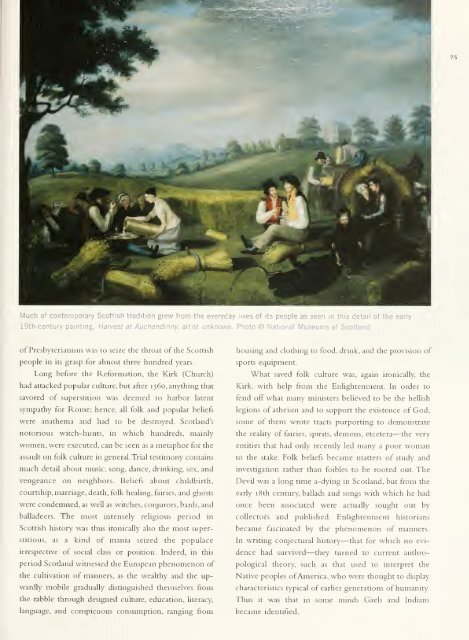SCOTLAND - Smithsonian Digital Repository - Smithsonian Institution
SCOTLAND - Smithsonian Digital Repository - Smithsonian Institution
SCOTLAND - Smithsonian Digital Repository - Smithsonian Institution
You also want an ePaper? Increase the reach of your titles
YUMPU automatically turns print PDFs into web optimized ePapers that Google loves.
Much of contemporary Scottish tradition grew from the everyday lives of its people as seen in this detail of the early<br />
19th-century painting,<br />
Harvest at Auchendinny, artist unknown. Photo © National Museums of Scotland<br />
of Presbyterianism was to seize the throat of the Scottish<br />
people in its grasp for almost three hundred years.<br />
Long before the Reformation, the Kirk (Church)<br />
had attacked popular culture, but after 1560, anything that<br />
savored of superstition was deemed to harbor latent<br />
sympathy for Rome; hence, all folk and popular beHefs<br />
were anathema and had to be destroyed. Scotland's<br />
notorious witch-hunts, in which hundreds, mainly<br />
women, were executed, can be seen as a metaphor for the<br />
assault on folk culture in general. Trial testimony contains<br />
much detail about music, song, dance, drinking, sex, and<br />
vengeance on neighbors. Beliefs about childbirth,<br />
courtship, marriage, death, folk heahng, fairies, and ghosts<br />
were condemned, as well as witches, conjurors, bards, and<br />
balladeers. The most intensely religious period in<br />
Scottish history was thus ironically also the most superstitious,<br />
as a kind of mania seized the populace<br />
irrespective of social class or position. Indeed, in this<br />
period Scotland witnessed the European phenomenon of<br />
the cultivation of manners, as the wealthy and the upwardly<br />
mobile gradually distinguished themselves from<br />
the rabble through designed culture, education, hteracy,<br />
language, and conspicuous consumption, ranging from<br />
housing and clothing to food, drink, and the provision of<br />
sports equipment.<br />
What saved folk culture was, again ironically, the<br />
Kirk, with help from the Enlightenment. In order to<br />
fend off what many ministers believed to be the hellish<br />
legions of atheism and to support the existence of God,<br />
some of them wrote tracts purporting to demonstrate<br />
the reality<br />
of fairies, spirits, demons, etcetera—the very<br />
entities that had only recently led many a poor woman<br />
to the stake. Folk beliefs became matters of study and<br />
investigation rather than foibles to be rooted out. The<br />
Devil was a long time a-dying in Scotland, but from the<br />
early i8th century, ballads and songs with which he had<br />
once been associated were actually sought out by<br />
collectors and published. Enlightenment historians<br />
became fascinated by the phenomenon of manners.<br />
In writing conjectural history—that for which no evidence<br />
had survived—they turned to current anthropological<br />
theory, such as that used to interpret the<br />
Native peoples ofAmerica, who were thought to display<br />
characteristics typical of earlier generations of humanity.<br />
Thus it was that in some minds Gaels and Indians<br />
became identified.
















